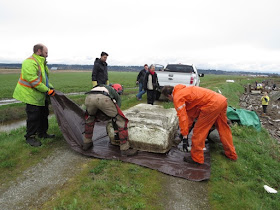Oct 3-24 2016 Various Locations
Lower Mainland BC.
Forest Scenes
"Bathed in Sunlight"
How the forest around Brydon Lagoon had changed in a few weeks.
The brilliant sunshine which had lit up the leaves of the vine maples had been replaced by autumn rainfall and even a few frosty nights. The leaves that had been so colourful had now curled and fallen to the ground.
On the plus side, the ruby-crowned kinglets and black-capped chickadees were now far easier to see.
 |
| A ruby-crowned kinglet picking off insects. |
 |
| Ruby-crowned kinglet. |
A Pacific wren sat on its favourite perch, then as quickly as it had appeared, it was gone.
 |
| High ISO camera setting made this shot possible. |
"Forest Bathing"....Really!
"A recent article in the Vancouver Sun by Marc and Craig Kielburger claim the trend of "forest bathing" has been popular in Japan for the past decade and has now spread to North America where some doctors, holistic and traditional are now prescribing 90 minute walks in the forest to reduce blood pressure etc.
In my opinion it's something that has been around for millennia, it's just that some have just lost the ability to interact with nature and need a doctor's permission to commune with nature. What a crazy world!
I'm always amazed about how many people complain about the weather here in BC. According to my journal there were so far, only three days in 2016 that weren't birdable due to inclement weather.
A flock of bushtits suddenly appeared out of nowhere. Full of character they'll brighten up anyone's day. I waited for a catchlight in the bushtit's eye before pressing the shutter.
 |
| Bushtit |
On recent visits to Brydon Lagoon I was surprised to see a very large flock of cackling geese. Most of the geese were only slightly larger than mallards. Some but not all had a rufous breast while many were charcoal coloured. Some had a plain breast, others had a white ring around the neck. Adding to the confusion there are several sub-species of cackling geese, some of which might have been present.
 |
| Cackling Goose (Branta hutchinsii) |
The birds have been hanging around for most of October, flying in and out several times during the day. They spent their evenings resting and feeding on nearby farmland. Amongst the cackling geese (Ridgeway's) were some larger cacklers but still too small to be Canada Geese.
The larger Canada Geese (Branta canadensis) weren't that impressed by having "their"lagoon taken over by their smaller cousins and spent most of their days in a nearby backwater.
Cackling Geese Nikon P900
|
 |
| Amanita muscaria (fly agaric) at Reifel |
My favourite place to find Amanita Muscaria is along the inner first paths at Reifel.
On the shoreline
Meanwhile down at the Tsawwassen FerryTerminal the birding has been very good with a great variety of species.
 |
| Common Loon |
Photographed in the pouring rain at a low angle the large bill and the white eye ring are tell tale signs that this is a juvenile common loon. This species spend their winters on the coast and return to inland lakes to nest in the spring.
Always a joy to photograph, Lapland Longspurs are quite tolerant to humans and left their own devices will continue to feed if given enough space. Best approached and photographed from a car or by a low angled approach.
 |
| Non-breeding male Lapland Longspur. |
 |
| Lapland longspur. |
 |
| Lapland longspur |
 |
| Black oystercatcher. |
 |
| Black turnstone. |
Safety in numbers
 |
| Whimbrel and black oystercatcher. |
A lone whimbrel find companionship with a flock of black oystercatchers. The whimbrel feeds on small crabs and the oystercatchers shellfish. I'm sure the whimbrel finds shelter amongst the oystercatchers especially with predators like peregrine falcons and bald eagles patrolling the shoreline.
White Rock Pier
 |
| This surf scoter has learnt to pluck mussels off the White Rock pier stanctions at low tide. |
 |
| Female surf scoter. |
 |
| Male surf scoter |
A walk around Stokes Pit with Cos and Carlo produced some good birds. The extensive trails produced some good views of ruby-crowned kinglets and at the very end of the walk, a pileated woodpecker.
 |
| Pileated Woodpecker |
The following day we went back to Latimer Pond with a plastic bag to pick up garbage and while walking the woods my wife and I were surrounded by a mixed flock of bushtits, chestnut-backed chickadees, golden-and ruby-crowned kinglets and a lone downy woodpecker. We spent an amazing ten minutes standing motionless while the flock of about thirty birds fed around us..truly a magical moment.
Finally but not least a hermit thrush feeding on mountain ash or rowan berries in Richmond at end of Blundell Rd. Originally I was looking for the Townsend's Solitaire but i'll settle for this beauty.
If you have reached this far I thank you and hope you continue too revel and bathe in nature as often as possible,
Until next time.
"Its never to late to start getting outdoors"
John Gordon
Langley/Cloverdale
BC Canada


















